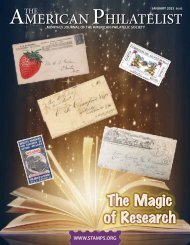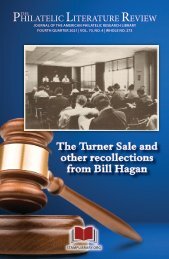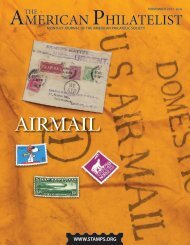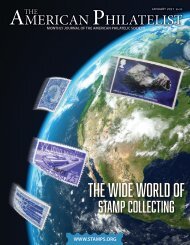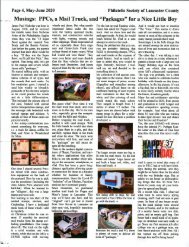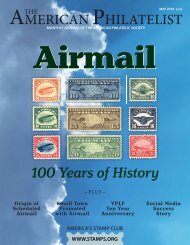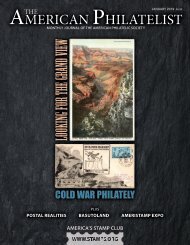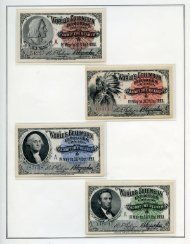August 2018 - Sneak Peek
The American Philatelist is the monthly journal of the American Philatelic Society, the world's largest organization for stamp collectors and enthusiasts. Members receive the printed magazine and can access the digital edition as a benefit of membership in the Society. Please enjoy this sneak peek. We're confident that once you see all that we offer, you'll want to join the APS today.
The American Philatelist is the monthly journal of the American Philatelic Society, the world's largest organization for stamp collectors and enthusiasts. Members receive the printed magazine and can access the digital edition as a benefit of membership in the Society. Please enjoy this sneak peek. We're confident that once you see all that we offer, you'll want to join the APS today.
You also want an ePaper? Increase the reach of your titles
YUMPU automatically turns print PDFs into web optimized ePapers that Google loves.
Figure 15. On April 7, 1933, it became legal to manufacture and sell beer with an alcohol<br />
content of less than 3.2 percent. This cover marks that event, complete with a Pabst label<br />
affixed to the reverse with the “does not contain more than 4 percent of alcohol by volume.”<br />
Figure 16. Efforts to reintroduce various forms of Prohibition did not end in 1933. This 1940 mailing<br />
was sent by the Anti-Saloon League of Ohio.<br />
Prohibition.” Juror 12, featured on<br />
the cover, is a racketeer. A “Vote<br />
for Repeal” label is also tied to the<br />
cover by postmark.<br />
The repeal of Prohibition<br />
was actually a two-act play. Because<br />
of the Harrison-Cullen Act,<br />
signed March 22, 1933, by President<br />
Franklin Roosevelt, which<br />
amended the Volstead Act (raising<br />
the legal alcohol content in<br />
beer from 0.5 percent to 3.2 percent),<br />
it became legal to manufacture<br />
and sell beer and light wines<br />
on April 7, 1933, as evidenced<br />
by the celebratory cover shown<br />
[Figure 15]. While this was a<br />
huge win for Roosevelt’s administration,<br />
there was still a bigger<br />
battle ahead. After all, prior to<br />
Prohibition, taxes on alcohol had<br />
provided about 14 percent of the<br />
total federal state and local tax<br />
revenues for the country.<br />
Finally, on December 5, 1933,<br />
the 18th Amendment was repealed<br />
by the ratification of the<br />
21st Amendment to the U.S.<br />
Constitution (ironically the tipping<br />
state was Utah). The repeal,<br />
however, was not carte blanche.<br />
The amendment does not restrict<br />
states from banning or restricting<br />
alcohol and its use; instead,<br />
in addition to repealing the 18th<br />
Amendment, the following wording<br />
was added: “The transportation<br />
or importation into any State,<br />
Territory, or possession of the<br />
United States for delivery or use<br />
therein of intoxicating liquors, in<br />
violation of the laws thereof, is<br />
hereby prohibited.” This allowed<br />
state and local control. Indeed,<br />
Mississippi was dry until 1966<br />
and Kansas prohibited public bars<br />
until 1987. Many counties remain<br />
dry.<br />
Even after the death of Prohibition,<br />
there have been many<br />
attempts to reinstate it. For example,<br />
the Anti-Saloon League<br />
of Ohio was active as evidenced<br />
by this cover sent in 1940 [Figure<br />
16]. Although the contents<br />
750 AMERICAN PHILATELIST / AUGUST <strong>2018</strong>




